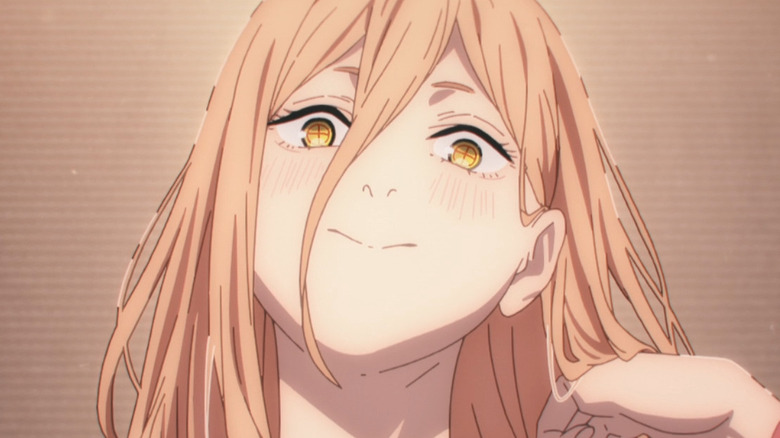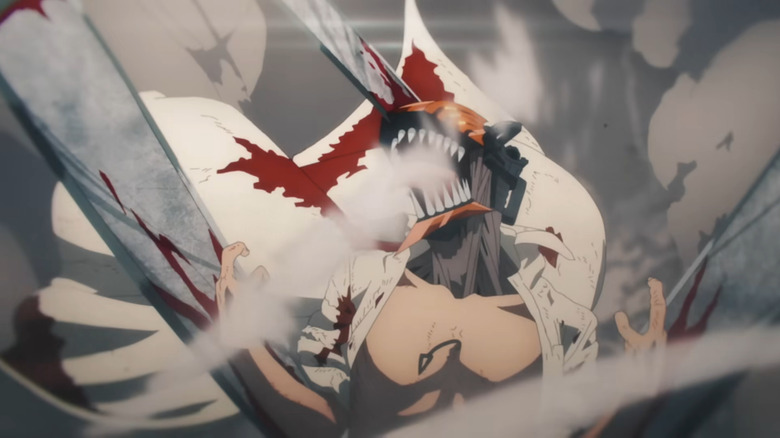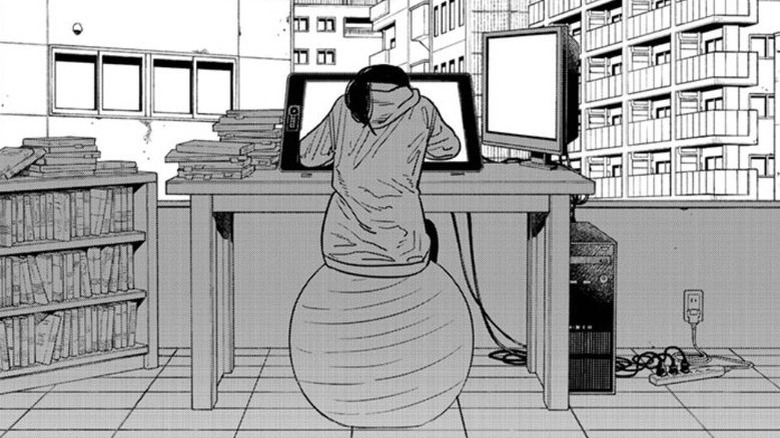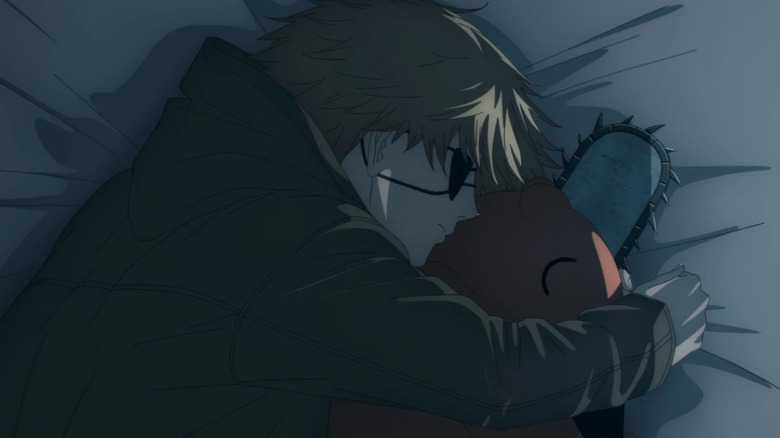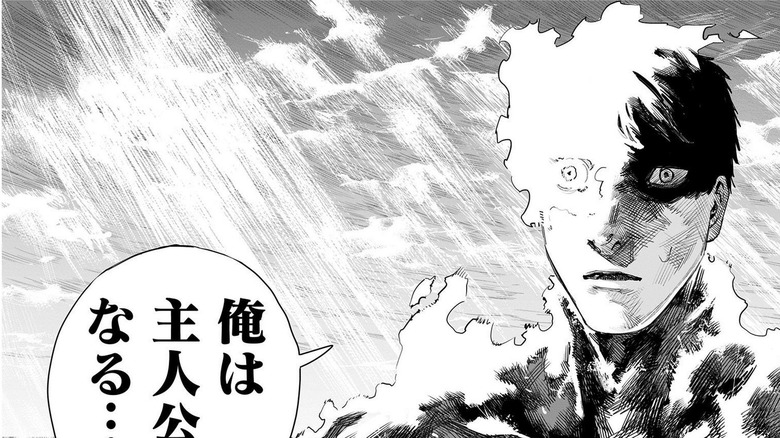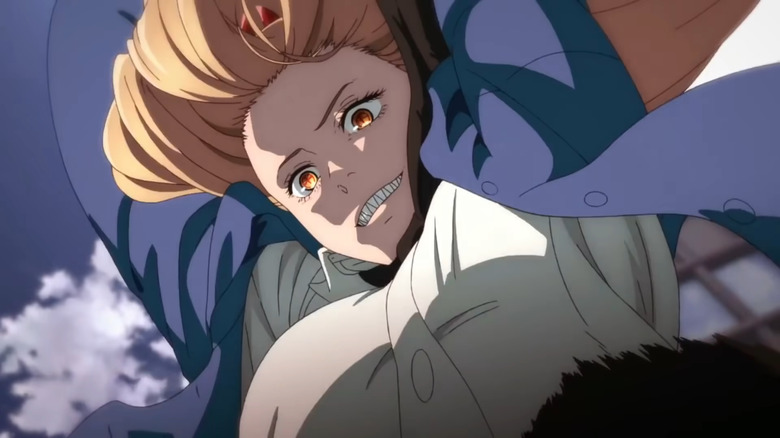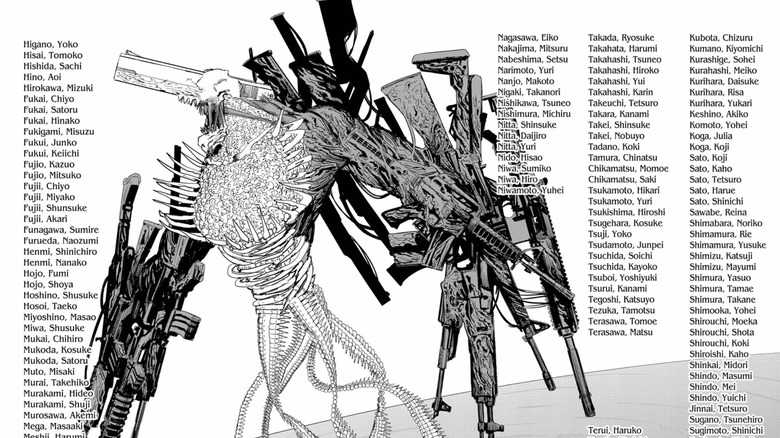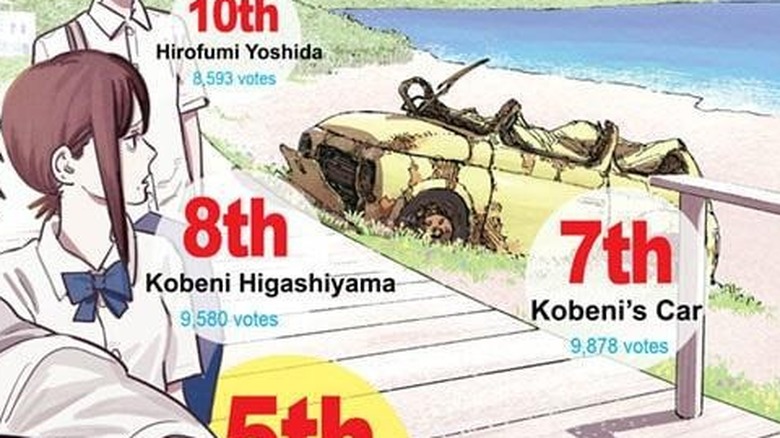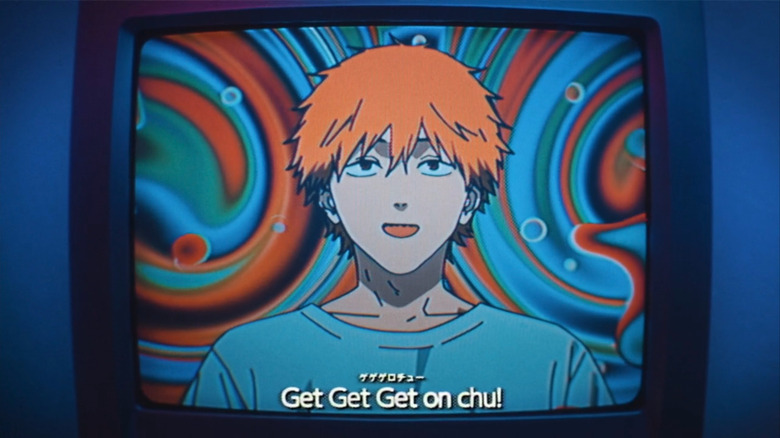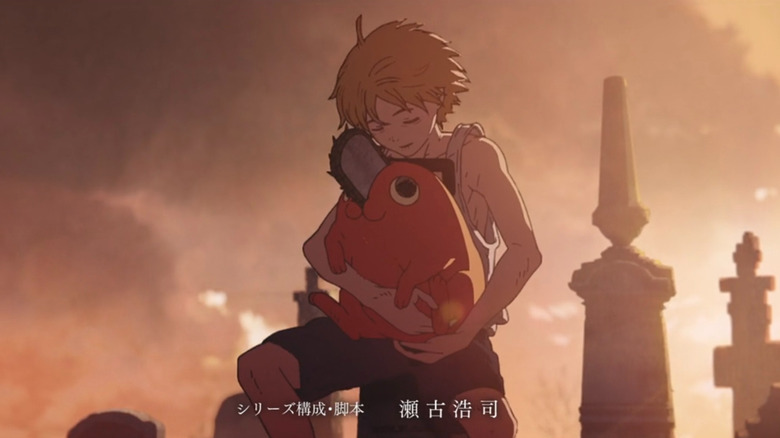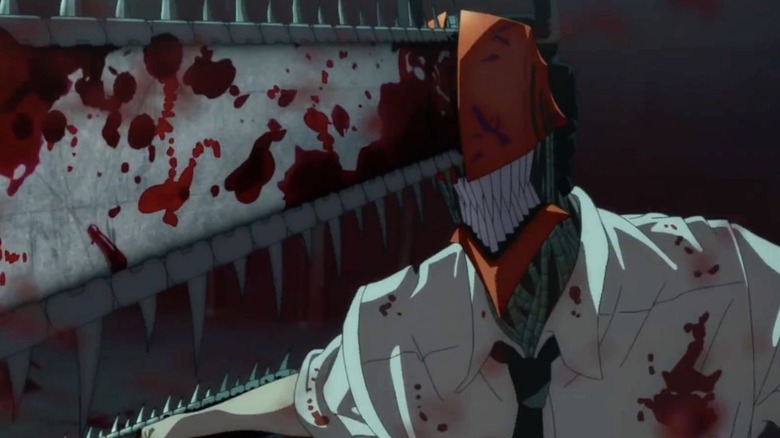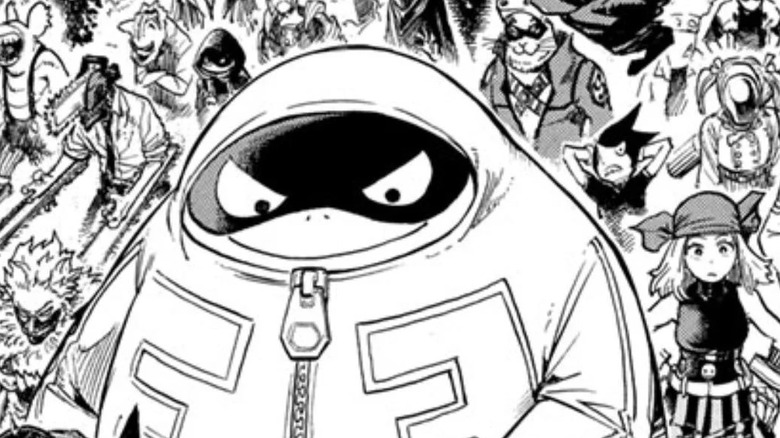12 Chainsaw Man Facts Manga Fans Should Cut Through
No anime title took the world by storm faster than "Chainsaw Man" in 2022, based on the eponymous manga written by Tatsuki Fujimoto. The story follows Denji, a 16-year-old boy stuck in a life of abject poverty, hunting low-level devils for the Yakuza. After making a posthumous deal with his devil-canine companion Pochita, Denji is reborn as the titular Chainsaw Man. Now Denji, at the behest of the lovely yet intimidating "Miss" Makima, is thrust into a job at Public Safety. Forced to cohabitate with the straightlaced Aki and the boisterous blood fiend Power, Denji's life becomes complicated very quickly.
From top to bottom, both the manga and the anime are a treat for any fan of horror films and Shonen-style stories. With a creator so elusive and a creation so bizarre, there are many interesting facts that many fans are unaware of. So sit back and enjoy 12 Chainsaw Man facts manga fans should cut through – spoilers for the manga and anime ahead!
The anime's trailer cracked 11 million views
From the moment an anime adaptation was announced, hardcore fans of the manga were intrigued but definitely cautious. Manga adaptations are tough enough as it is, so a translation of "Chainsaw Man" was going to be subject to some added scrutiny. However, the first trailer finally dropped on September 19, 2022, on the official MAPPA studio YouTube channel, eventually amassing over 5 million in a day (via Anime Corner). Add to that, two million views in just an hour on Twitter.
From there, the hype for "Chainsaw Man" season 1 set the anime community ablaze, with the fandom growing bigger than ever. From fan art to cosplays to countless musical edits on YouTube, the world has seemingly embraced Fujimoto's special brand of madness. With Season 1 now officially in the books, fans are now gobbling up the rest of the manga, eagerly awaiting the next season of the anime.
Tatsuki Fujimoto's unconventional origins
Upon first glance, there are a few different things that set "Chainsaw Man" apart from the typical Shonen manga or anime. Its style has kinetic energy and a crunchy feel to it, aided by Fujimoto's often chaotic yet somehow precise pencil work. The best pages of the manga are the ones that ooze a palpable sense of not only dread but relatability as well. For every horrific, blood-drenched devil battle, there is a calm, often very gentle scene to balance it out.
Impressive, especially considering that the artistic origins of Fujimoto are most definitely unconventional, even when compared to the likes of other manga creators. For starters, Fujimoto didn't even pursue the usual artistic prerequisites of a manga illustrator — things like figure drawing, layout, inking, and paneling. In fact, in an interview with Shonen Jump SP, Fujimoto mentioned that he majored in oil painting at his university. For a sizable chunk of Fujimoto's syndicated career, we've been seeing him grow and improve in real time which is a truly wonderful thing to see.
Tatsuki Fujimoto based Denji's beginnings off of his own
From his first moments on screen, Denji immediately establishes himself as one of modern anime's most relatable characters. In Episode 1, we're shown just how miserable Denji's life is as a low-level devil hunter indentured to the Yakuza. Aided only by his devil-canine companion Pochita, Denji doesn't have lofty dreams — wishing only for jam on bread and to play video games with a pretty girl.
It wouldn't be a stretch to say that Denji's desire for baseline accommodations is very much in line with the current generation. In a world where gig and hustle culture is growing exponentially, stability and sustainability seem perpetually unattainable for many.
In an interview with BFMTV, Fujimoto noted: "When you look at the current young generation, they're kind of like that. They're not looking for a very high salary. They are content with 350,000 yen a month. They try to live in a simple way, day by day. I don't criticize them." Fujimoto also said in a two-part Shonen Jump interview (translated via Sword Translations), that "I was also a deadbeat after I graduated, and the rent where I lived was 20,000 yen. It didn't have AC, so that was tough." This is just one of many examples of how Fujimoto's personal tastes and experiences have wormed their way into the plotting and characters of his manga.
It has an even darker predecessor
From its violence to its often-unexpected character deaths to the distressing nature of its deeper themes, "Chainsaw Man" Season 1 isn't the typical Shonen Jump fare. The story of "Chainsaw Man" is frequently a bleak one, with moments that'll have your mouth agape and your eyes thoroughly watering. What many fans of the series might be surprised to learn is that it's not Fujimoto's first rodeo with a serialized manga title.
Yes, before there was "Chainsaw Man," there was "Fire Punch," which ran from April 2016 to January 2018 through the Shonen Jump+ website. What's even more surprising, especially for those unfamiliar with it, is just how dark "Fire Punch" is, even more so than "Chainsaw Man."
The opening pages see the protagonist Agni, who possesses the power of regeneration, severing and regrowing his own limbs to serve as a food source for his village. This is then one-upped by a man named Doma setting him ablaze with an internal flame that never goes out. The flame, in conjunction with Agni's regeneration ability, basically means that he's in excruciating agony all of the time. Bear in mind, this is just the setup for the rest of the manga which doesn't make any significant strides to become any more pleasant. If you've never read "Fire Punch," definitely do so, as it's an unrelenting yet enthralling story that'll inform your further enjoyment of "Chainsaw Man."
The inspiration for Power
In terms of popularity, you'd be hard-pressed to find a "Chainsaw Man" character more beloved than Power. It's explained that Power is a fiend, a devil who is currently inhabiting the body of a deceased human. When she isn't going on naked murder rampages in the forest, Power is a slave of Public Safety helping to dispatch other devils. In addition to being racist towards humans, Power is also a pathological liar, even going as far as to alter her own memories to win arguments. Add to that, her incessant refusal to flush the toilet, bathe or eat her vegetables and she's basically the little sister from hell. Her hysterical dynamic with both Denji and Aki quickly becomes a major highlight of the manga and the anime adaptation.
If Power's egotistical, often delusional, and boisterous nature seems familiar to you, that's because she had a very popular inspiration. In a 2020 interview with ATOM (translated and archived via Reddit), Fujimoto stated: "I draw inspiration from works that I love. For example, in 'Chainsaw Man' the character of Power evokes Eric Cartman from 'South Park,' a series that I adore." Bizarrely enough, both characters have amassed respective body counts, though we doubt Power would be creative enough to turn two dead parents into chili.
The Gun Devil's Death List has some easter eggs
Throughout the first arc of "Chainsaw Man," as well as the anime's first season, we are told about the Gun Devil. Due to an uptick in gun violence in the world of "Chainsaw Man," the fear of guns is higher than ever, resulting in the arrival of the Gun Devil. Though never shown in full until much later on in the manga, we're told that when the Gun Devil hit Japan for just 26 seconds, he killed 57,912 people. This is the catalyst for Aki joining Public Safety as a Devil Hunter, as the Gun Devil's attack wiped out his entire family.
Anime fans will likely be waiting a while to see the Gun Devil fully realized, as he doesn't physically appear until the manga's 75th chapter. This second attack, mainly focused on the city of Nikaho in Akita, claims anyone in a 1,000-meter radius — specifically every living thing born in January, February, March, May, June, August, September, November, or December.
This immense death toll is literally illustrated by a chilling list of alphabetical names spread out over the artwork on the subsequent pages. However, many of the listed names have been identified as the names of fellow manga scribes, including Kohei Horikoshi, Eiichiro Oda, Hajime Isayama, and Tite Kubo. These are the respective creators of My Hero Academia, One Piece, Attack on Titan, and Bleach, all past and current fan favorites.
Kobeni's car is more popular than Kobeni
If ever a fictional character deserved a hug and a shoulder to cry on, it would be poor Kobeni from "Chainsaw Man." Kobeni is first introduced during the Infinity Devil arc as one of the Devil Hunters working under Aki during a mission to a hotel. It quickly becomes clear that Kobeni is a walking bucket of anxiety and insecurity, even ready to stab Denji just to escape the Infinity Devil. Kobeni reveals she only took a job with public safety in order to support her family. However, despite her timid demeanor, Kobeni is shown to be quite efficient when it counts — even saving Denji from Katana Man during the attack on Public Safety.
Later on in the manga, it's shown that Kobeni has bought a car for herself, which is quickly appropriated and abused by Power resulting in horrific hilarity. For whatever reason, Kobeni's car has taken on a life of its own, especially via the world of social media. In fact, as evident through a fan poll, Kobeni's car is actually far more popular than Kobeni which is both on-brand and tragically hilarious.
The series doesn't take place in modern day
Many stories — albeit in film, animation, or print — will often quickly establish when and where they take place to better immerse the viewer or reader. For example, if a story shows current tech such as Apple products and Tesla cars, it's safe to assume it's set fairly close to its date of release. Some narratives, like "Batman: The Animated Series," skirt the line a little bit, not confirming any set date or year, more so to maintain a sense of timelessness. There are a few clues sprinkled throughout, one of the more confusing being a mention of the Union of Soviet Socialist Republics, AKA the USSR. However, when it comes to when "Chainsaw Man" is set, that's where things get a little bit interesting. For most of the manga's run, readers are never explicitly told when the story takes place, forcing fans to theorize on their own.
It isn't until the latter half of the manga's first arc that a concrete answer to that question finally arrived. In chapter 75, it's revealed that the Gun Devil's second attack occurred on September 12, 1997 — confirming that "Chainsaw Man" takes place in an alternative-1990s. This helps to explain the more antiquated cars and cell phones used by different characters throughout the manga and anime. This also explains why the ending credits sequence for episode seven is stylized with a distorted 90s-era CRT television filter.
Tatsuki Fujimoto is a massive movie fan
As fans of "Chainsaw Man" will be aware, Fujimoto has an affinity for cinematic references, especially toward movies he holds in high regard. His film fandom worming its way into his manga creations can be traced back to his one-shot "Goodbye, Eri" and even "Fire Punch" as well. In the aforementioned 2020 interview with ATOM, Fujimoto confirmed that the story of "Fire Punch" is influenced by "The Chaser," a Korean film directed by Na Hong-jin, saying, "I like its gloomy atmosphere and especially the unexpectedness of its plot."
However, the most obvious evidence of this is the opening title sequence for "Chainsaw Man" Season 1, which is loaded with homages to notable films. This includes references to the likes of "The Texas Chain Saw Massacre," "Reservoir Dogs," and even "The Big Lebowski." If you want to get even more granular with it, there are even references to other anime series as well. The title sequence contains references to the often-divisive "Neon Genesis Evangelion," a classic anime series that can definitely match "Chainsaw Man" in terms of abject nihilism.
Aside from overt visual references, it's very clear Fujimoto has infused his work with themes and ideas culled from his favorite films. Fujimoto's personal experiences and interests have become a key element of his work — his love for cinema is no exception.
Makima is Fujimoto's ideal woman
It's very clear through interviews that Fujimoto has given that he is a shy but very kind soul, however, there's no denying he very much has a type. In addition to a bizarre sense of humor and a penchant for grotesque violence, Fujimoto has a noticeable affinity for dominant women. Many "Chainsaw Man" fans have picked up on this from analyzing the bizarre relationship between Denji and Makima. After being taken in by Makima, Denji is forced into a very submissive position as her dog. Denji, at several points in the manga and anime, even barks like one to please her. At first, this is played for comedy, but as the story progresses, these bizarre overtones only increase in discomfort.
Dynamics like this make a lot more sense if you hear Fujimoto provide context for it in an interview published in Shonen Jump SQ. The section most relevant here has been translated by Kyle Scouter on Twitter which reads: "When a girl in University turned my bike over, I thought how happy I am." Some fans have even looked at Denji and Makima's "relationship" and have noted how it's a dark deconstruction of different abusive relationships.
The anime's studio has seen some recent controversy
As amazing as the success of "Chainsaw Man" has been, we can't pretend that there isn't a sizable elephant in the room. That being the rumors and allegations emerging from the people working behind the scenes at Studio MAPPA, the Japanese studio behind the anime adaptation.
MAPPA has been behind many modern anime juggernauts including — "Yuri!!! on Ice," the final season of "Attack on Titan," and most recently, "Chainsaw Man." However, behind all of these accomplishments is a very unpleasant situation we might not even have the full scope of yet. As reported by the Anime News Network in 2021, a freelance artist named Mushiyo came forward on Twitter with some legitimate horror stories about working for MAPPA. This includes nightmarish conditions including employees allegedly being forced to multitask on several major shows at once, often fixing drawings until late into the night. Mushiyo went on to explain that it was these alleged insufferable working conditions that have led to a whopping 80% of their staff walking out on them.
From there these claims caught on like wildfire which eventually led to MAPPA releasing a public statement to address the matter. Simply put, MAPPA opted to write off certain claims such as low pay and abysmal working conditions. As we said, this is still an ongoing situation, so we can only hope the situation over at MAPPA improves for any artists still involved.
Denji has cameoed in another popular manga
You may have heard the phrase "game recognizes game" in passing, what it means essentially is two people of high skill showing mutual respect. The anime and manga communities are no strangers to this trend, with creators often praising each other's creations in various ways. We already mentioned Fujimoto's use of several prominent manga creators' names in the Gun Devil's multi-page death list. One of the creators mentioned was Kohei Horikoshi, the man behind the current Shonen superhero hit, "My Hero Academia." Much like "Chainsaw Man," the series has gone on to help define the current generation of manga and anime.
Both men clearly have respect for each other's work, with Horikoshi even returning the favor in the 259th chapter of "My Hero Academia." Featured amongst a sizable group shoot filled with many heroes you'll spy a familiar chainsaw-adorned character. That's right, Denji in Chainsaw Man form is shown right alongside Gang Orca, Midnight, Fat Gum, and many others. While we're never given a chance to see this variant of Denji in action, it's still cool to see him cameo within the pages of another manga.
